PHAR 1000 Challenge Assignment 1: Nurse Refresher - Case Studies
VerifiedAdded on 2023/04/26
|15
|3085
|376
Homework Assignment
AI Summary
This practical nurse refresher assignment addresses two scenarios: one involving hormone replacement therapy (HRT) for a perimenopausal woman with heart disease, and the other concerning azithromycin administration to an infant. The HRT scenario explores the hormones involved, their mechanism of action, side effects, contraindications, and dosage calculations for estrogen, calcium, Vitamin D, and Fosamax. It concludes that HRT is not advisable for the patient due to her existing heart condition. The azithromycin scenario covers indications, mechanism of action, safe dosage calculation for a pediatric patient, appropriate route of administration, and nursing implications, including patient education for parents regarding dosage, potential side effects, and storage. The assignment emphasizes the importance of accurate dosage calculations and patient-specific considerations in medication administration. Desklib offers a wealth of similar solved assignments and study resources for nursing students.
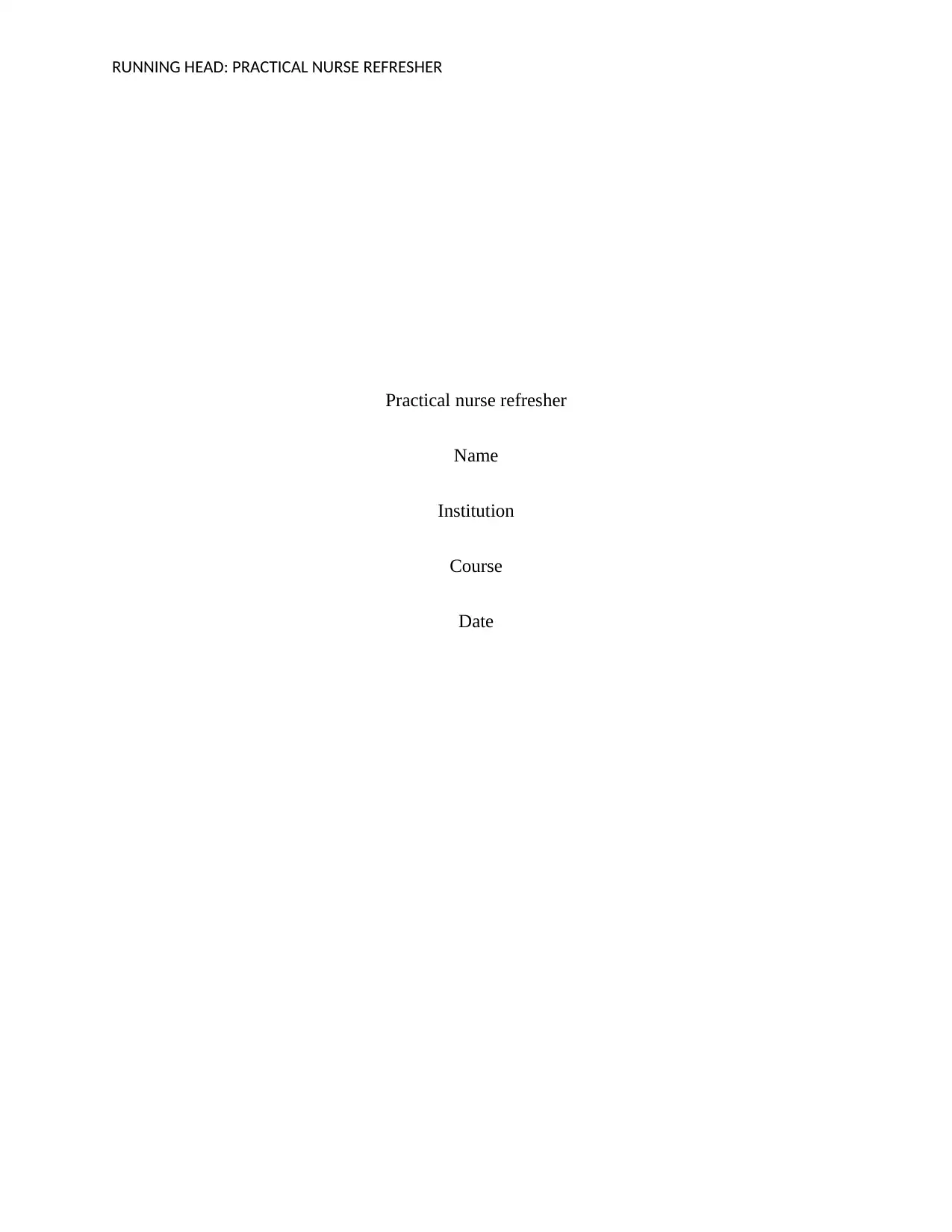
RUNNING HEAD: PRACTICAL NURSE REFRESHER
Practical nurse refresher
Name
Institution
Course
Date
Practical nurse refresher
Name
Institution
Course
Date
Paraphrase This Document
Need a fresh take? Get an instant paraphrase of this document with our AI Paraphraser
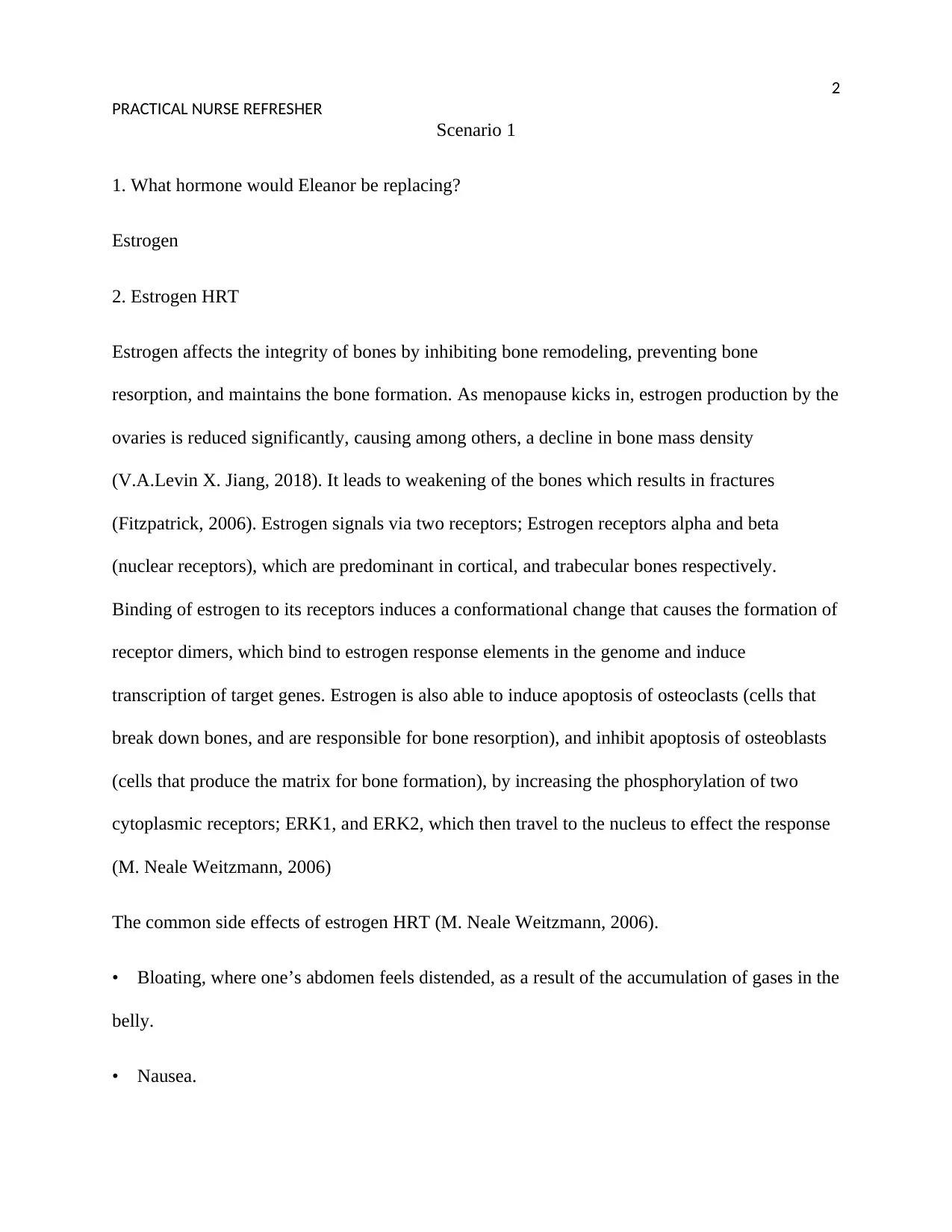
2
PRACTICAL NURSE REFRESHER
Scenario 1
1. What hormone would Eleanor be replacing?
Estrogen
2. Estrogen HRT
Estrogen affects the integrity of bones by inhibiting bone remodeling, preventing bone
resorption, and maintains the bone formation. As menopause kicks in, estrogen production by the
ovaries is reduced significantly, causing among others, a decline in bone mass density
(V.A.Levin X. Jiang, 2018). It leads to weakening of the bones which results in fractures
(Fitzpatrick, 2006). Estrogen signals via two receptors; Estrogen receptors alpha and beta
(nuclear receptors), which are predominant in cortical, and trabecular bones respectively.
Binding of estrogen to its receptors induces a conformational change that causes the formation of
receptor dimers, which bind to estrogen response elements in the genome and induce
transcription of target genes. Estrogen is also able to induce apoptosis of osteoclasts (cells that
break down bones, and are responsible for bone resorption), and inhibit apoptosis of osteoblasts
(cells that produce the matrix for bone formation), by increasing the phosphorylation of two
cytoplasmic receptors; ERK1, and ERK2, which then travel to the nucleus to effect the response
(M. Neale Weitzmann, 2006)
The common side effects of estrogen HRT (M. Neale Weitzmann, 2006).
• Bloating, where one’s abdomen feels distended, as a result of the accumulation of gases in the
belly.
• Nausea.
PRACTICAL NURSE REFRESHER
Scenario 1
1. What hormone would Eleanor be replacing?
Estrogen
2. Estrogen HRT
Estrogen affects the integrity of bones by inhibiting bone remodeling, preventing bone
resorption, and maintains the bone formation. As menopause kicks in, estrogen production by the
ovaries is reduced significantly, causing among others, a decline in bone mass density
(V.A.Levin X. Jiang, 2018). It leads to weakening of the bones which results in fractures
(Fitzpatrick, 2006). Estrogen signals via two receptors; Estrogen receptors alpha and beta
(nuclear receptors), which are predominant in cortical, and trabecular bones respectively.
Binding of estrogen to its receptors induces a conformational change that causes the formation of
receptor dimers, which bind to estrogen response elements in the genome and induce
transcription of target genes. Estrogen is also able to induce apoptosis of osteoclasts (cells that
break down bones, and are responsible for bone resorption), and inhibit apoptosis of osteoblasts
(cells that produce the matrix for bone formation), by increasing the phosphorylation of two
cytoplasmic receptors; ERK1, and ERK2, which then travel to the nucleus to effect the response
(M. Neale Weitzmann, 2006)
The common side effects of estrogen HRT (M. Neale Weitzmann, 2006).
• Bloating, where one’s abdomen feels distended, as a result of the accumulation of gases in the
belly.
• Nausea.
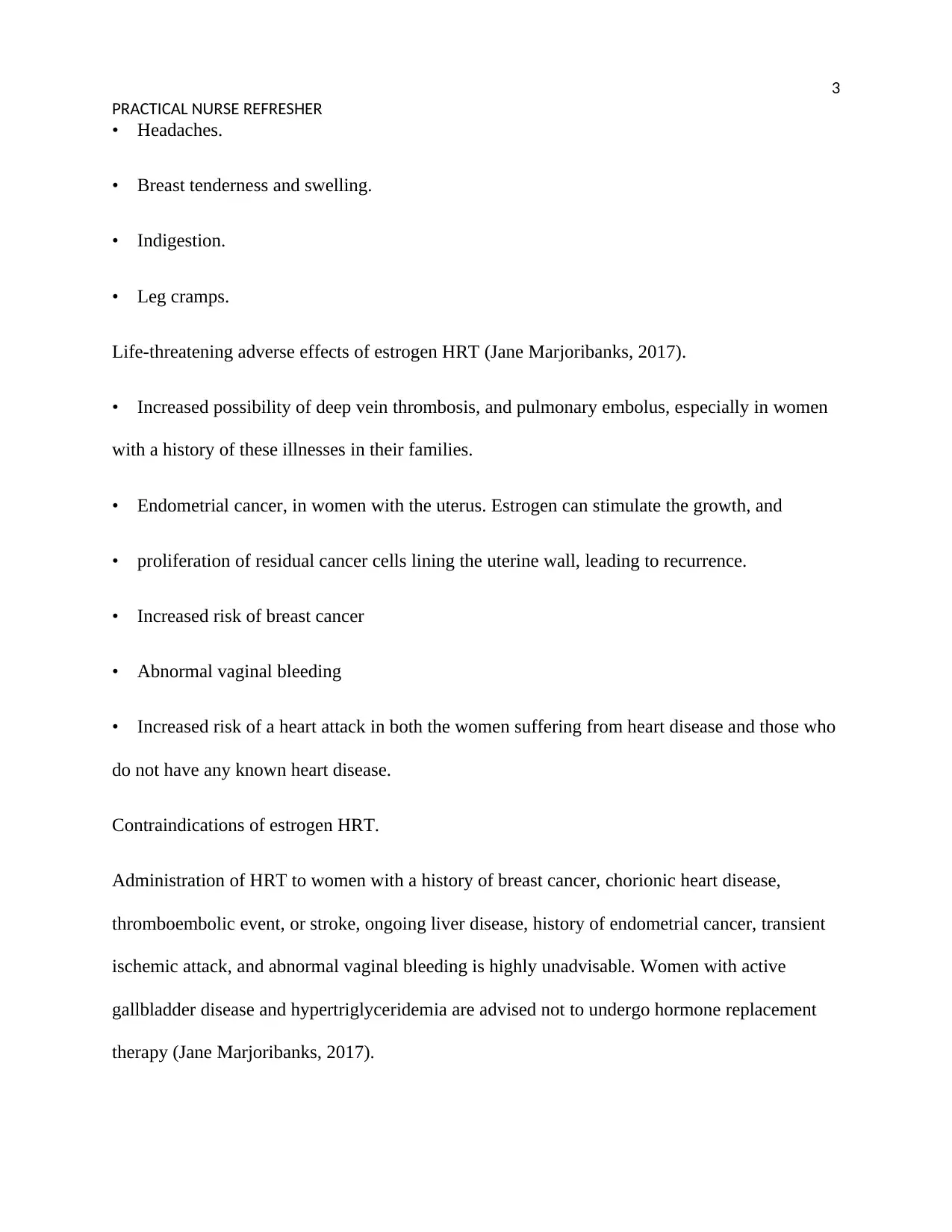
3
PRACTICAL NURSE REFRESHER
• Headaches.
• Breast tenderness and swelling.
• Indigestion.
• Leg cramps.
Life-threatening adverse effects of estrogen HRT (Jane Marjoribanks, 2017).
• Increased possibility of deep vein thrombosis, and pulmonary embolus, especially in women
with a history of these illnesses in their families.
• Endometrial cancer, in women with the uterus. Estrogen can stimulate the growth, and
• proliferation of residual cancer cells lining the uterine wall, leading to recurrence.
• Increased risk of breast cancer
• Abnormal vaginal bleeding
• Increased risk of a heart attack in both the women suffering from heart disease and those who
do not have any known heart disease.
Contraindications of estrogen HRT.
Administration of HRT to women with a history of breast cancer, chorionic heart disease,
thromboembolic event, or stroke, ongoing liver disease, history of endometrial cancer, transient
ischemic attack, and abnormal vaginal bleeding is highly unadvisable. Women with active
gallbladder disease and hypertriglyceridemia are advised not to undergo hormone replacement
therapy (Jane Marjoribanks, 2017).
PRACTICAL NURSE REFRESHER
• Headaches.
• Breast tenderness and swelling.
• Indigestion.
• Leg cramps.
Life-threatening adverse effects of estrogen HRT (Jane Marjoribanks, 2017).
• Increased possibility of deep vein thrombosis, and pulmonary embolus, especially in women
with a history of these illnesses in their families.
• Endometrial cancer, in women with the uterus. Estrogen can stimulate the growth, and
• proliferation of residual cancer cells lining the uterine wall, leading to recurrence.
• Increased risk of breast cancer
• Abnormal vaginal bleeding
• Increased risk of a heart attack in both the women suffering from heart disease and those who
do not have any known heart disease.
Contraindications of estrogen HRT.
Administration of HRT to women with a history of breast cancer, chorionic heart disease,
thromboembolic event, or stroke, ongoing liver disease, history of endometrial cancer, transient
ischemic attack, and abnormal vaginal bleeding is highly unadvisable. Women with active
gallbladder disease and hypertriglyceridemia are advised not to undergo hormone replacement
therapy (Jane Marjoribanks, 2017).
⊘ This is a preview!⊘
Do you want full access?
Subscribe today to unlock all pages.

Trusted by 1+ million students worldwide
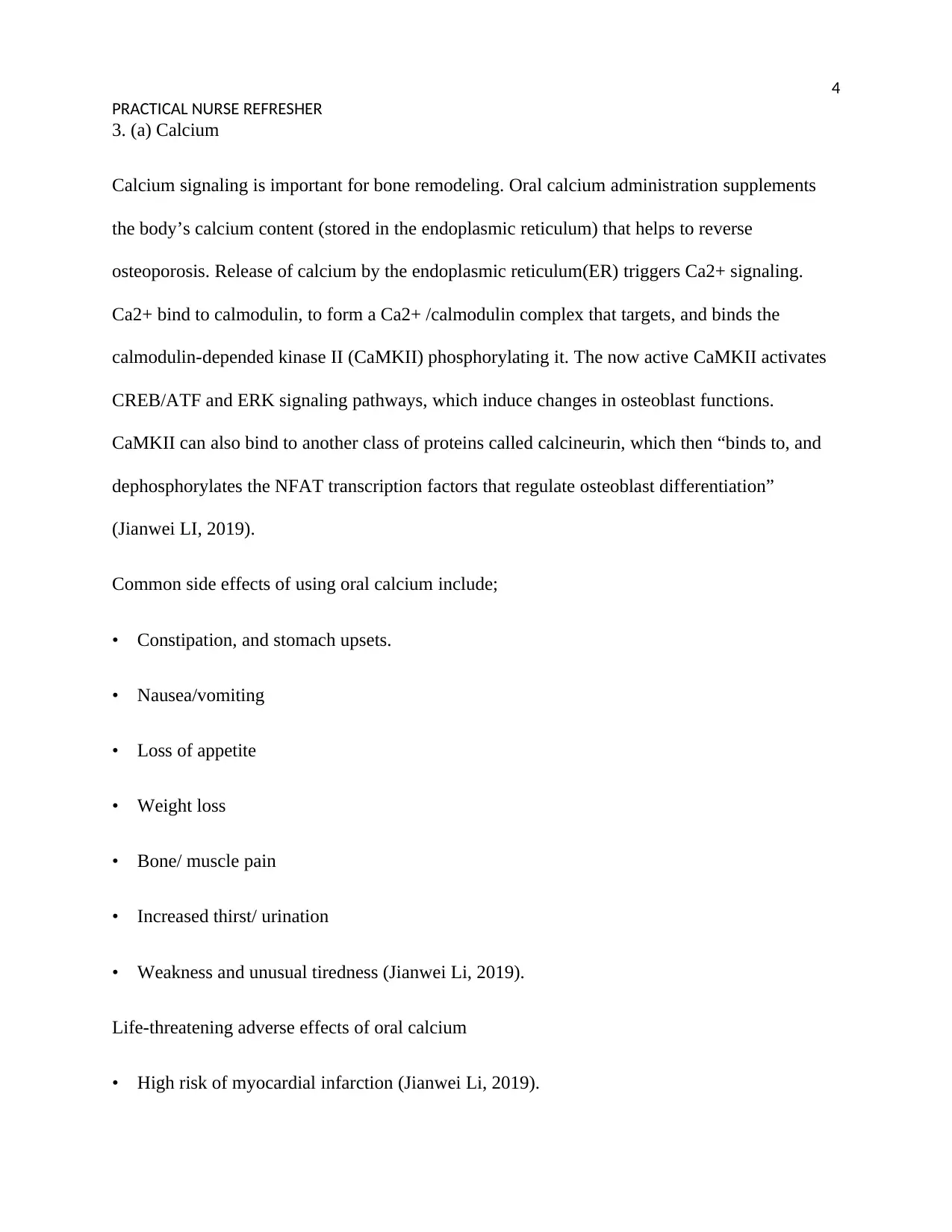
4
PRACTICAL NURSE REFRESHER
3. (a) Calcium
Calcium signaling is important for bone remodeling. Oral calcium administration supplements
the body’s calcium content (stored in the endoplasmic reticulum) that helps to reverse
osteoporosis. Release of calcium by the endoplasmic reticulum(ER) triggers Ca2+ signaling.
Ca2+ bind to calmodulin, to form a Ca2+ /calmodulin complex that targets, and binds the
calmodulin-depended kinase II (CaMKII) phosphorylating it. The now active CaMKII activates
CREB/ATF and ERK signaling pathways, which induce changes in osteoblast functions.
CaMKII can also bind to another class of proteins called calcineurin, which then “binds to, and
dephosphorylates the NFAT transcription factors that regulate osteoblast differentiation”
(Jianwei LI, 2019).
Common side effects of using oral calcium include;
• Constipation, and stomach upsets.
• Nausea/vomiting
• Loss of appetite
• Weight loss
• Bone/ muscle pain
• Increased thirst/ urination
• Weakness and unusual tiredness (Jianwei Li, 2019).
Life-threatening adverse effects of oral calcium
• High risk of myocardial infarction (Jianwei Li, 2019).
PRACTICAL NURSE REFRESHER
3. (a) Calcium
Calcium signaling is important for bone remodeling. Oral calcium administration supplements
the body’s calcium content (stored in the endoplasmic reticulum) that helps to reverse
osteoporosis. Release of calcium by the endoplasmic reticulum(ER) triggers Ca2+ signaling.
Ca2+ bind to calmodulin, to form a Ca2+ /calmodulin complex that targets, and binds the
calmodulin-depended kinase II (CaMKII) phosphorylating it. The now active CaMKII activates
CREB/ATF and ERK signaling pathways, which induce changes in osteoblast functions.
CaMKII can also bind to another class of proteins called calcineurin, which then “binds to, and
dephosphorylates the NFAT transcription factors that regulate osteoblast differentiation”
(Jianwei LI, 2019).
Common side effects of using oral calcium include;
• Constipation, and stomach upsets.
• Nausea/vomiting
• Loss of appetite
• Weight loss
• Bone/ muscle pain
• Increased thirst/ urination
• Weakness and unusual tiredness (Jianwei Li, 2019).
Life-threatening adverse effects of oral calcium
• High risk of myocardial infarction (Jianwei Li, 2019).
Paraphrase This Document
Need a fresh take? Get an instant paraphrase of this document with our AI Paraphraser
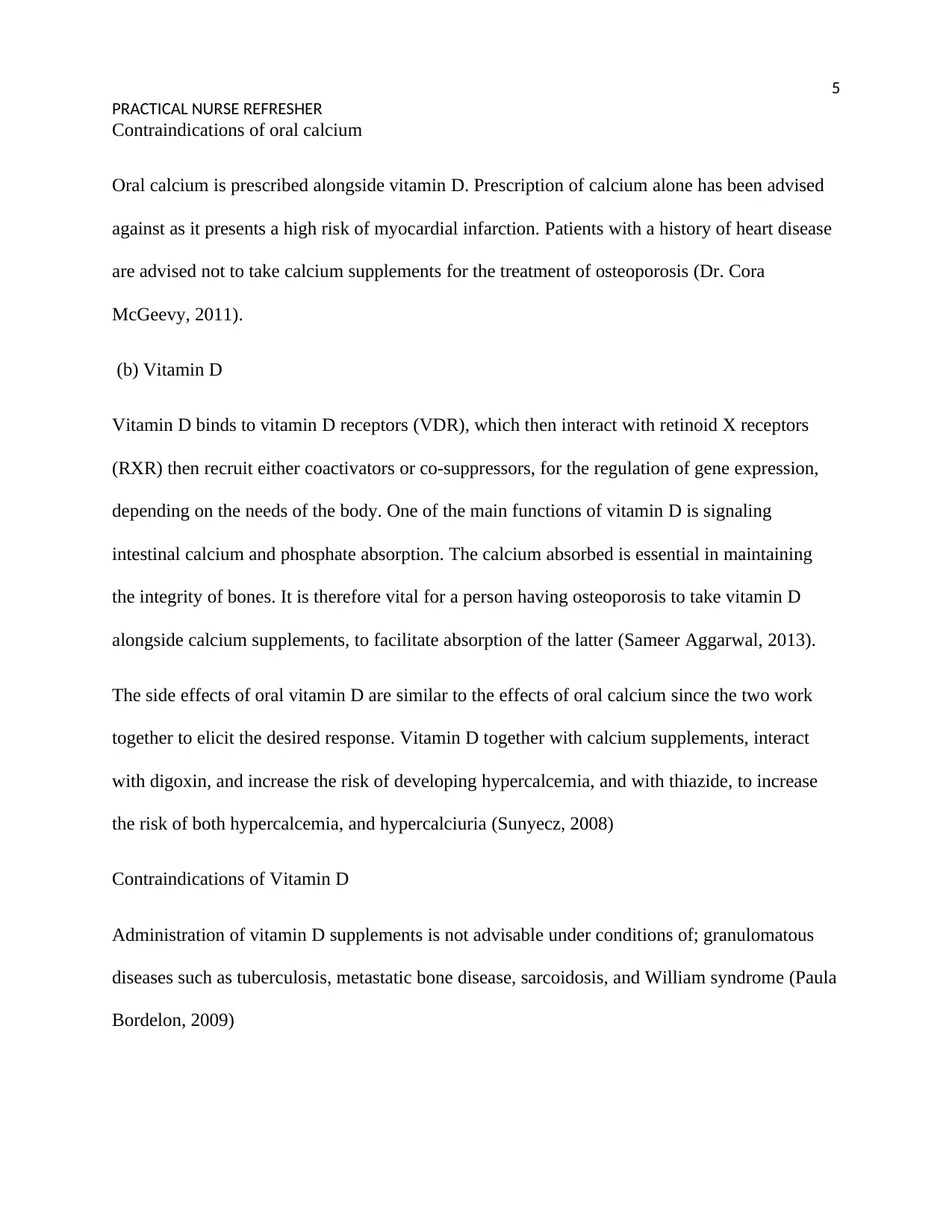
5
PRACTICAL NURSE REFRESHER
Contraindications of oral calcium
Oral calcium is prescribed alongside vitamin D. Prescription of calcium alone has been advised
against as it presents a high risk of myocardial infarction. Patients with a history of heart disease
are advised not to take calcium supplements for the treatment of osteoporosis (Dr. Cora
McGeevy, 2011).
(b) Vitamin D
Vitamin D binds to vitamin D receptors (VDR), which then interact with retinoid X receptors
(RXR) then recruit either coactivators or co-suppressors, for the regulation of gene expression,
depending on the needs of the body. One of the main functions of vitamin D is signaling
intestinal calcium and phosphate absorption. The calcium absorbed is essential in maintaining
the integrity of bones. It is therefore vital for a person having osteoporosis to take vitamin D
alongside calcium supplements, to facilitate absorption of the latter (Sameer Aggarwal, 2013).
The side effects of oral vitamin D are similar to the effects of oral calcium since the two work
together to elicit the desired response. Vitamin D together with calcium supplements, interact
with digoxin, and increase the risk of developing hypercalcemia, and with thiazide, to increase
the risk of both hypercalcemia, and hypercalciuria (Sunyecz, 2008)
Contraindications of Vitamin D
Administration of vitamin D supplements is not advisable under conditions of; granulomatous
diseases such as tuberculosis, metastatic bone disease, sarcoidosis, and William syndrome (Paula
Bordelon, 2009)
PRACTICAL NURSE REFRESHER
Contraindications of oral calcium
Oral calcium is prescribed alongside vitamin D. Prescription of calcium alone has been advised
against as it presents a high risk of myocardial infarction. Patients with a history of heart disease
are advised not to take calcium supplements for the treatment of osteoporosis (Dr. Cora
McGeevy, 2011).
(b) Vitamin D
Vitamin D binds to vitamin D receptors (VDR), which then interact with retinoid X receptors
(RXR) then recruit either coactivators or co-suppressors, for the regulation of gene expression,
depending on the needs of the body. One of the main functions of vitamin D is signaling
intestinal calcium and phosphate absorption. The calcium absorbed is essential in maintaining
the integrity of bones. It is therefore vital for a person having osteoporosis to take vitamin D
alongside calcium supplements, to facilitate absorption of the latter (Sameer Aggarwal, 2013).
The side effects of oral vitamin D are similar to the effects of oral calcium since the two work
together to elicit the desired response. Vitamin D together with calcium supplements, interact
with digoxin, and increase the risk of developing hypercalcemia, and with thiazide, to increase
the risk of both hypercalcemia, and hypercalciuria (Sunyecz, 2008)
Contraindications of Vitamin D
Administration of vitamin D supplements is not advisable under conditions of; granulomatous
diseases such as tuberculosis, metastatic bone disease, sarcoidosis, and William syndrome (Paula
Bordelon, 2009)
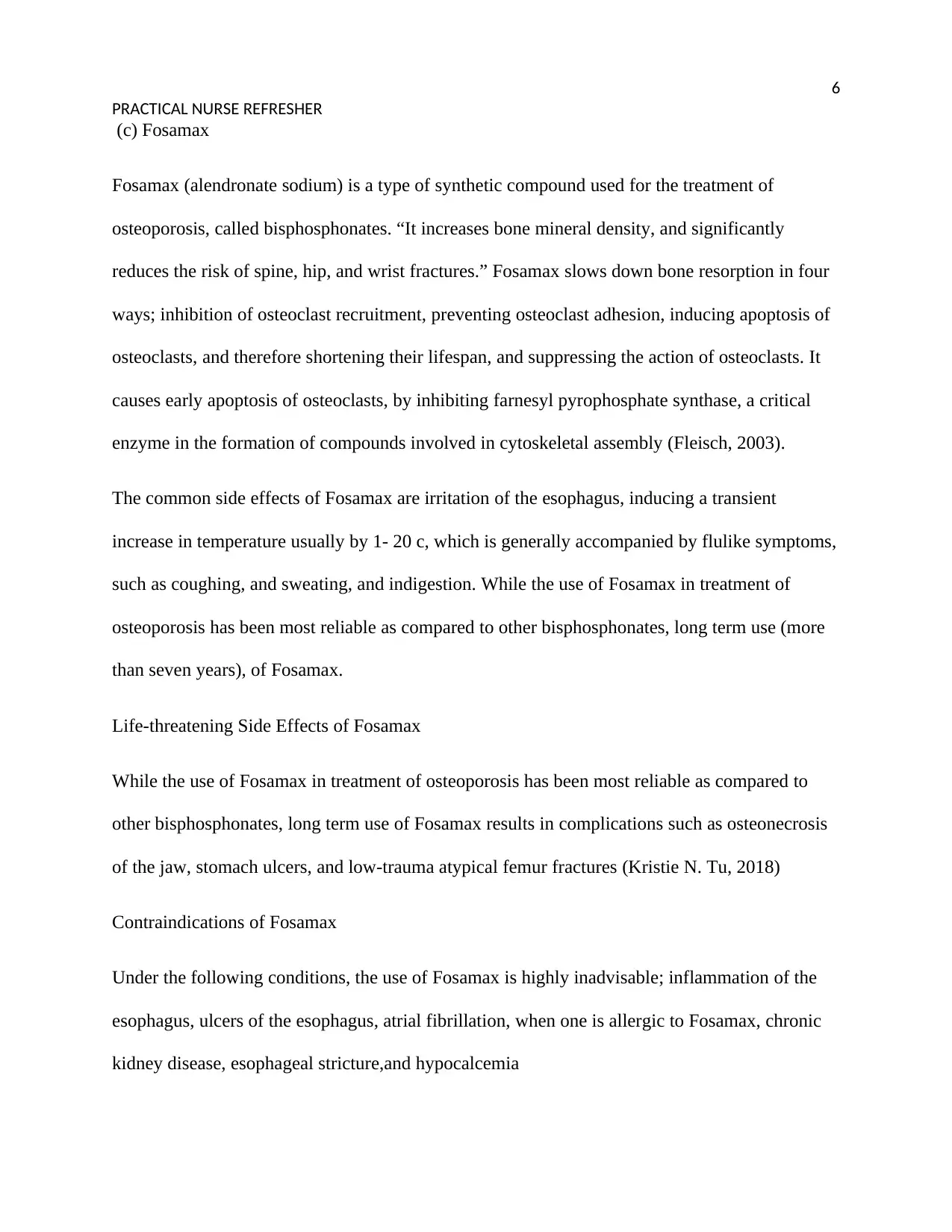
6
PRACTICAL NURSE REFRESHER
(c) Fosamax
Fosamax (alendronate sodium) is a type of synthetic compound used for the treatment of
osteoporosis, called bisphosphonates. “It increases bone mineral density, and significantly
reduces the risk of spine, hip, and wrist fractures.” Fosamax slows down bone resorption in four
ways; inhibition of osteoclast recruitment, preventing osteoclast adhesion, inducing apoptosis of
osteoclasts, and therefore shortening their lifespan, and suppressing the action of osteoclasts. It
causes early apoptosis of osteoclasts, by inhibiting farnesyl pyrophosphate synthase, a critical
enzyme in the formation of compounds involved in cytoskeletal assembly (Fleisch, 2003).
The common side effects of Fosamax are irritation of the esophagus, inducing a transient
increase in temperature usually by 1- 20 c, which is generally accompanied by flulike symptoms,
such as coughing, and sweating, and indigestion. While the use of Fosamax in treatment of
osteoporosis has been most reliable as compared to other bisphosphonates, long term use (more
than seven years), of Fosamax.
Life-threatening Side Effects of Fosamax
While the use of Fosamax in treatment of osteoporosis has been most reliable as compared to
other bisphosphonates, long term use of Fosamax results in complications such as osteonecrosis
of the jaw, stomach ulcers, and low-trauma atypical femur fractures (Kristie N. Tu, 2018)
Contraindications of Fosamax
Under the following conditions, the use of Fosamax is highly inadvisable; inflammation of the
esophagus, ulcers of the esophagus, atrial fibrillation, when one is allergic to Fosamax, chronic
kidney disease, esophageal stricture,and hypocalcemia
PRACTICAL NURSE REFRESHER
(c) Fosamax
Fosamax (alendronate sodium) is a type of synthetic compound used for the treatment of
osteoporosis, called bisphosphonates. “It increases bone mineral density, and significantly
reduces the risk of spine, hip, and wrist fractures.” Fosamax slows down bone resorption in four
ways; inhibition of osteoclast recruitment, preventing osteoclast adhesion, inducing apoptosis of
osteoclasts, and therefore shortening their lifespan, and suppressing the action of osteoclasts. It
causes early apoptosis of osteoclasts, by inhibiting farnesyl pyrophosphate synthase, a critical
enzyme in the formation of compounds involved in cytoskeletal assembly (Fleisch, 2003).
The common side effects of Fosamax are irritation of the esophagus, inducing a transient
increase in temperature usually by 1- 20 c, which is generally accompanied by flulike symptoms,
such as coughing, and sweating, and indigestion. While the use of Fosamax in treatment of
osteoporosis has been most reliable as compared to other bisphosphonates, long term use (more
than seven years), of Fosamax.
Life-threatening Side Effects of Fosamax
While the use of Fosamax in treatment of osteoporosis has been most reliable as compared to
other bisphosphonates, long term use of Fosamax results in complications such as osteonecrosis
of the jaw, stomach ulcers, and low-trauma atypical femur fractures (Kristie N. Tu, 2018)
Contraindications of Fosamax
Under the following conditions, the use of Fosamax is highly inadvisable; inflammation of the
esophagus, ulcers of the esophagus, atrial fibrillation, when one is allergic to Fosamax, chronic
kidney disease, esophageal stricture,and hypocalcemia
⊘ This is a preview!⊘
Do you want full access?
Subscribe today to unlock all pages.

Trusted by 1+ million students worldwide
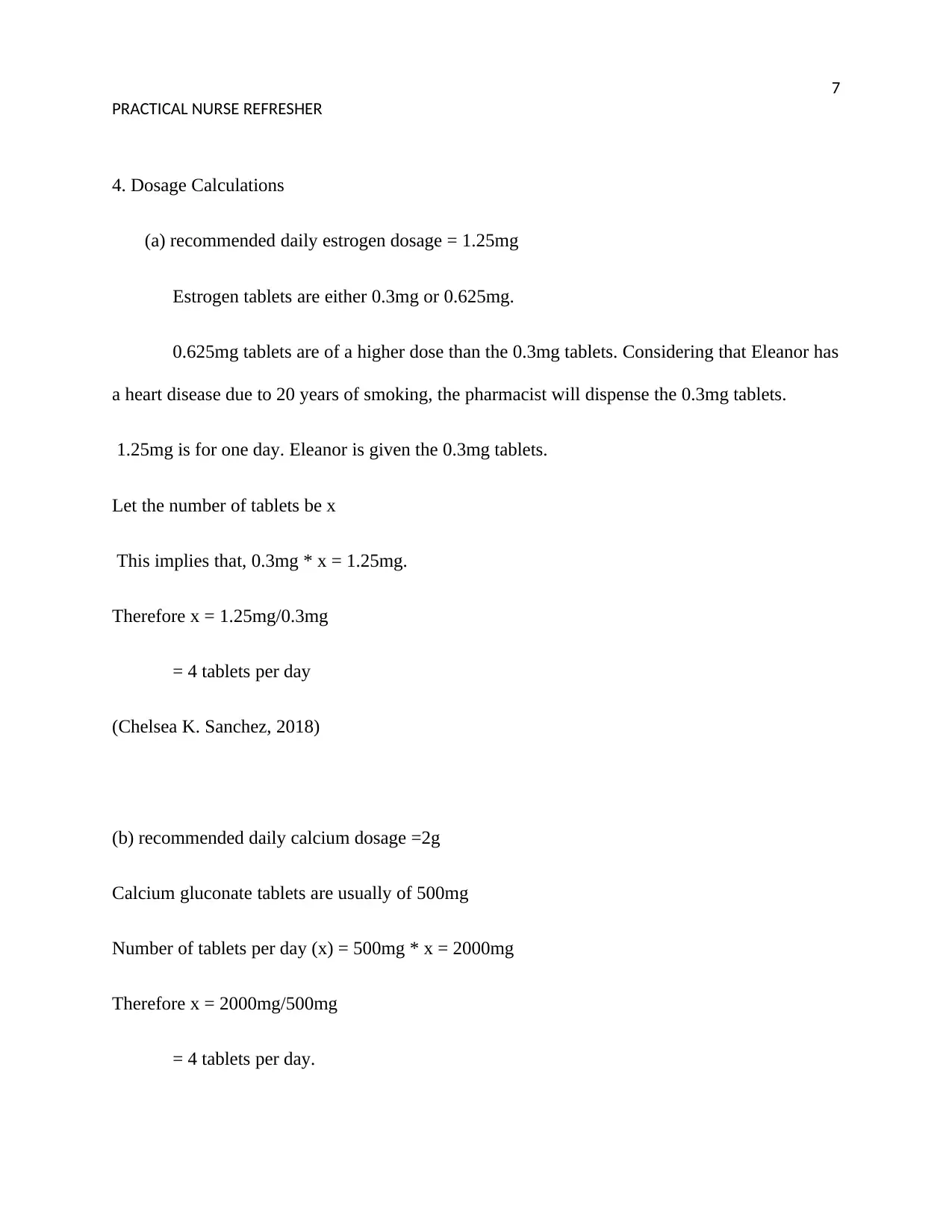
7
PRACTICAL NURSE REFRESHER
4. Dosage Calculations
(a) recommended daily estrogen dosage = 1.25mg
Estrogen tablets are either 0.3mg or 0.625mg.
0.625mg tablets are of a higher dose than the 0.3mg tablets. Considering that Eleanor has
a heart disease due to 20 years of smoking, the pharmacist will dispense the 0.3mg tablets.
1.25mg is for one day. Eleanor is given the 0.3mg tablets.
Let the number of tablets be x
This implies that, 0.3mg * x = 1.25mg.
Therefore x = 1.25mg/0.3mg
= 4 tablets per day
(Chelsea K. Sanchez, 2018)
(b) recommended daily calcium dosage =2g
Calcium gluconate tablets are usually of 500mg
Number of tablets per day (x) = 500mg * x = 2000mg
Therefore x = 2000mg/500mg
= 4 tablets per day.
PRACTICAL NURSE REFRESHER
4. Dosage Calculations
(a) recommended daily estrogen dosage = 1.25mg
Estrogen tablets are either 0.3mg or 0.625mg.
0.625mg tablets are of a higher dose than the 0.3mg tablets. Considering that Eleanor has
a heart disease due to 20 years of smoking, the pharmacist will dispense the 0.3mg tablets.
1.25mg is for one day. Eleanor is given the 0.3mg tablets.
Let the number of tablets be x
This implies that, 0.3mg * x = 1.25mg.
Therefore x = 1.25mg/0.3mg
= 4 tablets per day
(Chelsea K. Sanchez, 2018)
(b) recommended daily calcium dosage =2g
Calcium gluconate tablets are usually of 500mg
Number of tablets per day (x) = 500mg * x = 2000mg
Therefore x = 2000mg/500mg
= 4 tablets per day.
Paraphrase This Document
Need a fresh take? Get an instant paraphrase of this document with our AI Paraphraser
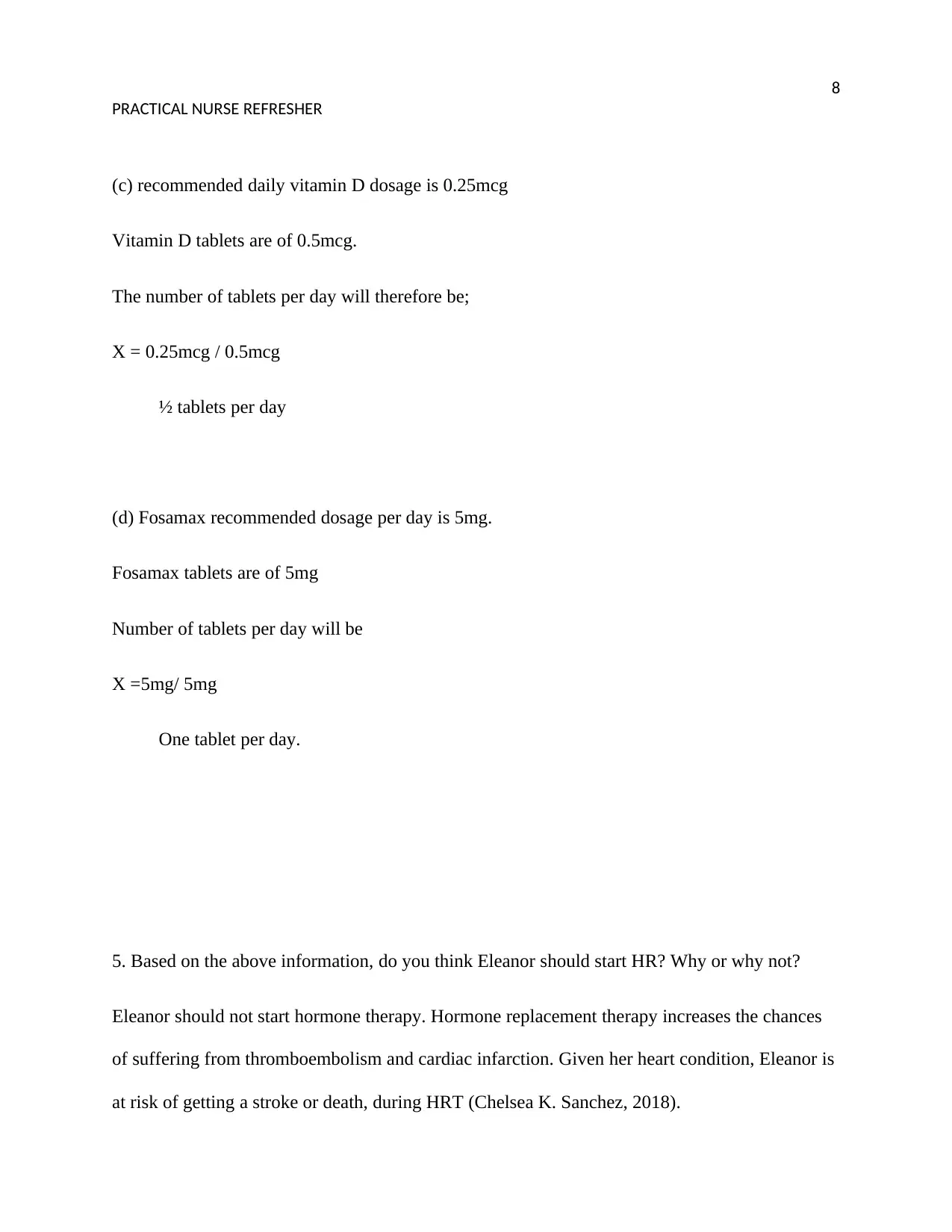
8
PRACTICAL NURSE REFRESHER
(c) recommended daily vitamin D dosage is 0.25mcg
Vitamin D tablets are of 0.5mcg.
The number of tablets per day will therefore be;
X = 0.25mcg / 0.5mcg
½ tablets per day
(d) Fosamax recommended dosage per day is 5mg.
Fosamax tablets are of 5mg
Number of tablets per day will be
X =5mg/ 5mg
One tablet per day.
5. Based on the above information, do you think Eleanor should start HR? Why or why not?
Eleanor should not start hormone therapy. Hormone replacement therapy increases the chances
of suffering from thromboembolism and cardiac infarction. Given her heart condition, Eleanor is
at risk of getting a stroke or death, during HRT (Chelsea K. Sanchez, 2018).
PRACTICAL NURSE REFRESHER
(c) recommended daily vitamin D dosage is 0.25mcg
Vitamin D tablets are of 0.5mcg.
The number of tablets per day will therefore be;
X = 0.25mcg / 0.5mcg
½ tablets per day
(d) Fosamax recommended dosage per day is 5mg.
Fosamax tablets are of 5mg
Number of tablets per day will be
X =5mg/ 5mg
One tablet per day.
5. Based on the above information, do you think Eleanor should start HR? Why or why not?
Eleanor should not start hormone therapy. Hormone replacement therapy increases the chances
of suffering from thromboembolism and cardiac infarction. Given her heart condition, Eleanor is
at risk of getting a stroke or death, during HRT (Chelsea K. Sanchez, 2018).
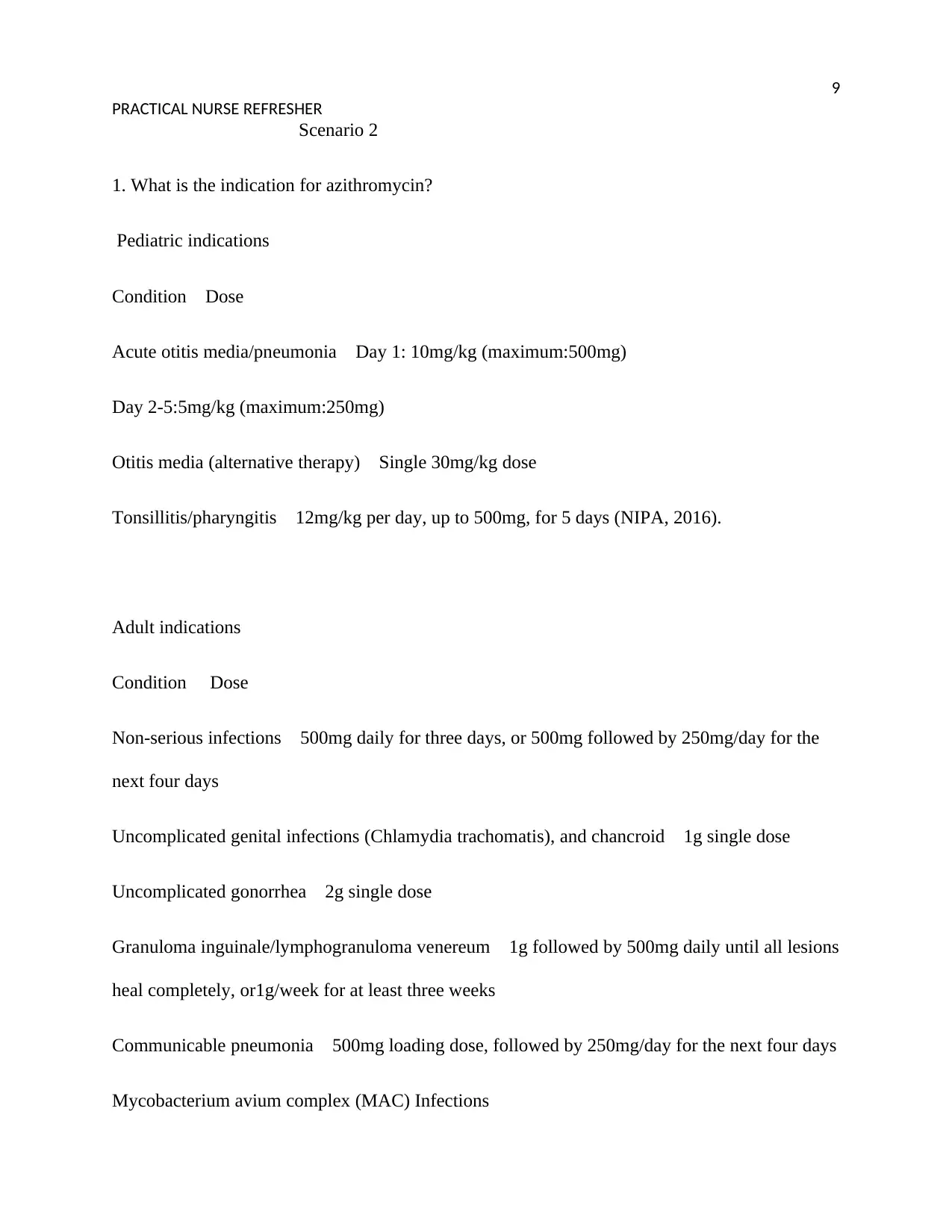
9
PRACTICAL NURSE REFRESHER
Scenario 2
1. What is the indication for azithromycin?
Pediatric indications
Condition Dose
Acute otitis media/pneumonia Day 1: 10mg/kg (maximum:500mg)
Day 2-5:5mg/kg (maximum:250mg)
Otitis media (alternative therapy) Single 30mg/kg dose
Tonsillitis/pharyngitis 12mg/kg per day, up to 500mg, for 5 days (NIPA, 2016).
Adult indications
Condition Dose
Non-serious infections 500mg daily for three days, or 500mg followed by 250mg/day for the
next four days
Uncomplicated genital infections (Chlamydia trachomatis), and chancroid 1g single dose
Uncomplicated gonorrhea 2g single dose
Granuloma inguinale/lymphogranuloma venereum 1g followed by 500mg daily until all lesions
heal completely, or1g/week for at least three weeks
Communicable pneumonia 500mg loading dose, followed by 250mg/day for the next four days
Mycobacterium avium complex (MAC) Infections
PRACTICAL NURSE REFRESHER
Scenario 2
1. What is the indication for azithromycin?
Pediatric indications
Condition Dose
Acute otitis media/pneumonia Day 1: 10mg/kg (maximum:500mg)
Day 2-5:5mg/kg (maximum:250mg)
Otitis media (alternative therapy) Single 30mg/kg dose
Tonsillitis/pharyngitis 12mg/kg per day, up to 500mg, for 5 days (NIPA, 2016).
Adult indications
Condition Dose
Non-serious infections 500mg daily for three days, or 500mg followed by 250mg/day for the
next four days
Uncomplicated genital infections (Chlamydia trachomatis), and chancroid 1g single dose
Uncomplicated gonorrhea 2g single dose
Granuloma inguinale/lymphogranuloma venereum 1g followed by 500mg daily until all lesions
heal completely, or1g/week for at least three weeks
Communicable pneumonia 500mg loading dose, followed by 250mg/day for the next four days
Mycobacterium avium complex (MAC) Infections
⊘ This is a preview!⊘
Do you want full access?
Subscribe today to unlock all pages.

Trusted by 1+ million students worldwide
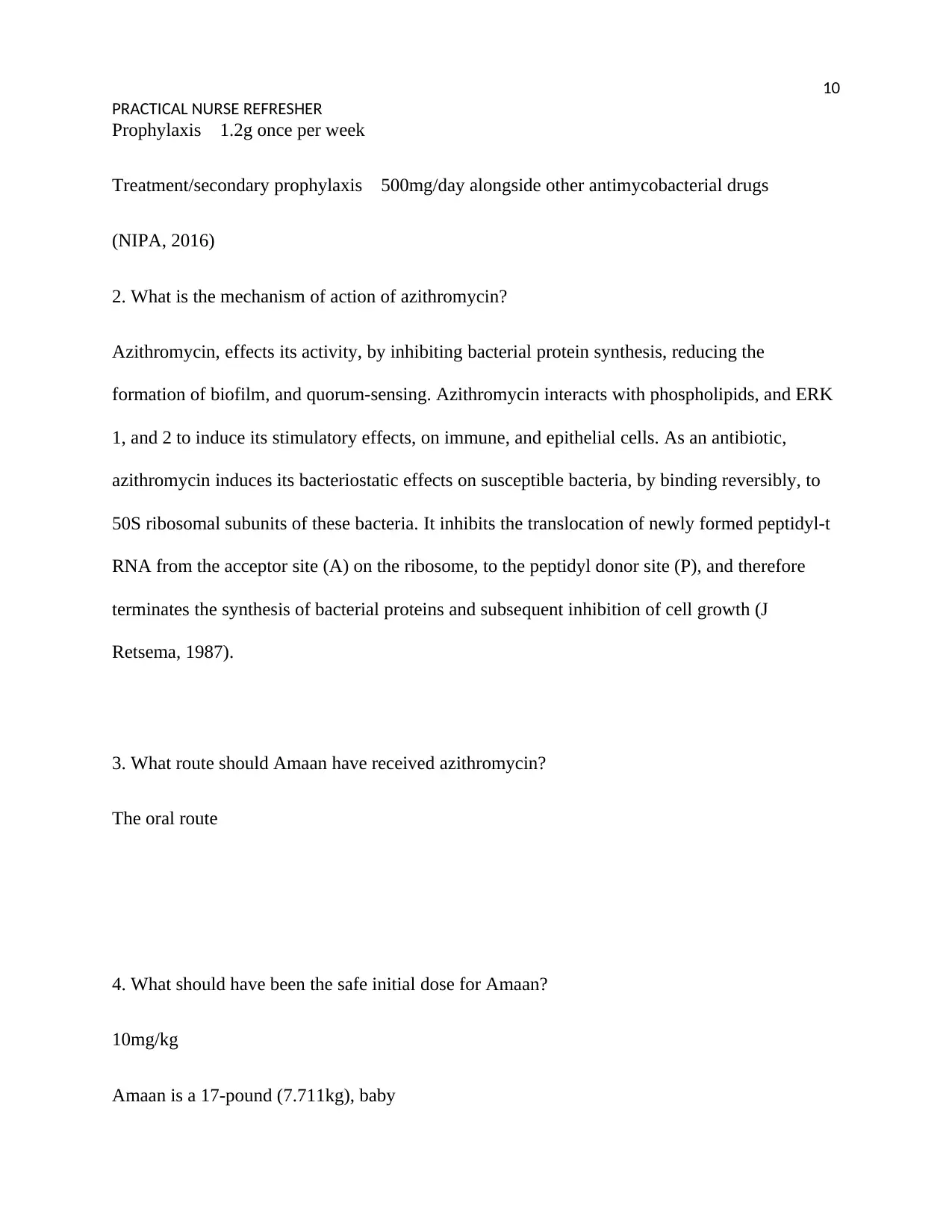
10
PRACTICAL NURSE REFRESHER
Prophylaxis 1.2g once per week
Treatment/secondary prophylaxis 500mg/day alongside other antimycobacterial drugs
(NIPA, 2016)
2. What is the mechanism of action of azithromycin?
Azithromycin, effects its activity, by inhibiting bacterial protein synthesis, reducing the
formation of biofilm, and quorum-sensing. Azithromycin interacts with phospholipids, and ERK
1, and 2 to induce its stimulatory effects, on immune, and epithelial cells. As an antibiotic,
azithromycin induces its bacteriostatic effects on susceptible bacteria, by binding reversibly, to
50S ribosomal subunits of these bacteria. It inhibits the translocation of newly formed peptidyl-t
RNA from the acceptor site (A) on the ribosome, to the peptidyl donor site (P), and therefore
terminates the synthesis of bacterial proteins and subsequent inhibition of cell growth (J
Retsema, 1987).
3. What route should Amaan have received azithromycin?
The oral route
4. What should have been the safe initial dose for Amaan?
10mg/kg
Amaan is a 17-pound (7.711kg), baby
PRACTICAL NURSE REFRESHER
Prophylaxis 1.2g once per week
Treatment/secondary prophylaxis 500mg/day alongside other antimycobacterial drugs
(NIPA, 2016)
2. What is the mechanism of action of azithromycin?
Azithromycin, effects its activity, by inhibiting bacterial protein synthesis, reducing the
formation of biofilm, and quorum-sensing. Azithromycin interacts with phospholipids, and ERK
1, and 2 to induce its stimulatory effects, on immune, and epithelial cells. As an antibiotic,
azithromycin induces its bacteriostatic effects on susceptible bacteria, by binding reversibly, to
50S ribosomal subunits of these bacteria. It inhibits the translocation of newly formed peptidyl-t
RNA from the acceptor site (A) on the ribosome, to the peptidyl donor site (P), and therefore
terminates the synthesis of bacterial proteins and subsequent inhibition of cell growth (J
Retsema, 1987).
3. What route should Amaan have received azithromycin?
The oral route
4. What should have been the safe initial dose for Amaan?
10mg/kg
Amaan is a 17-pound (7.711kg), baby
Paraphrase This Document
Need a fresh take? Get an instant paraphrase of this document with our AI Paraphraser
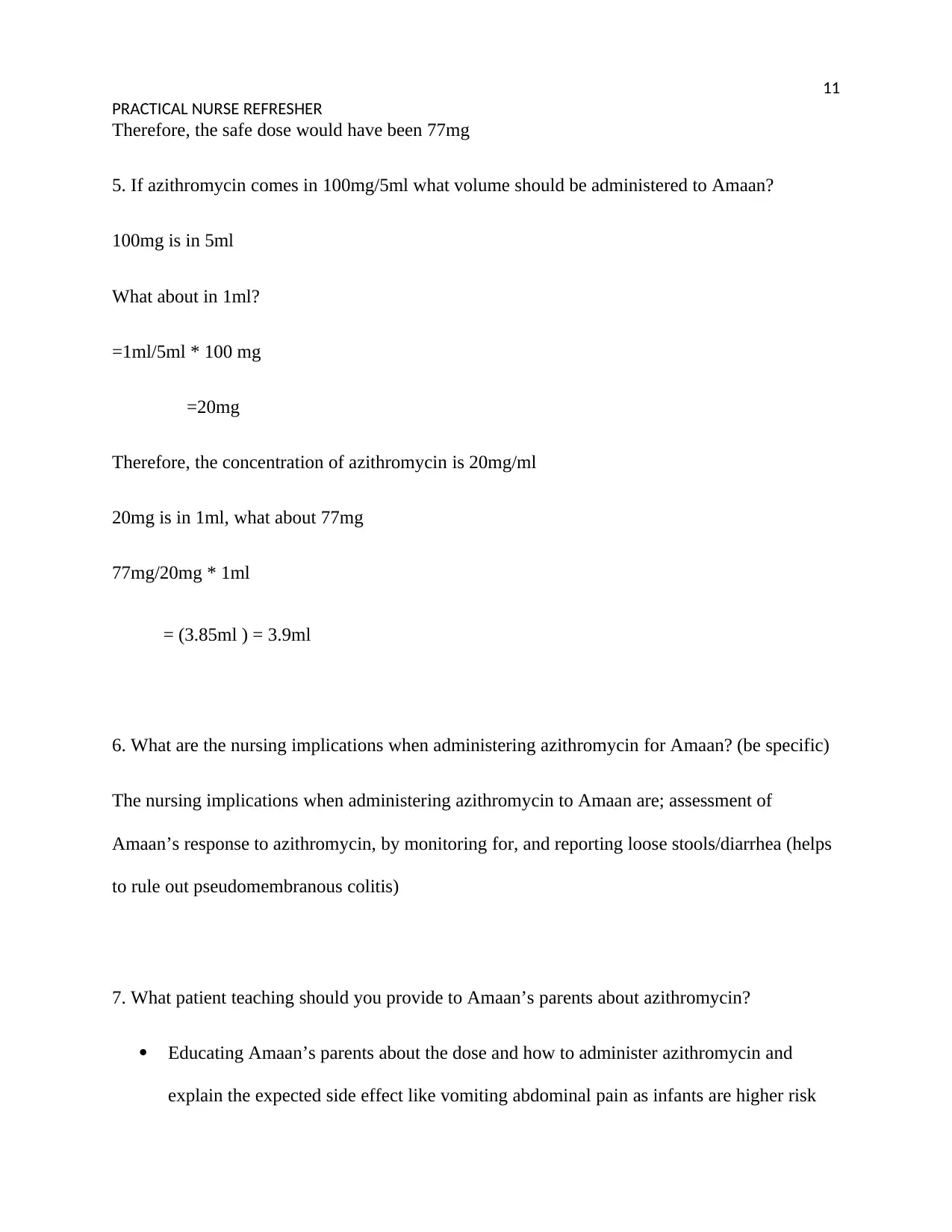
11
PRACTICAL NURSE REFRESHER
Therefore, the safe dose would have been 77mg
5. If azithromycin comes in 100mg/5ml what volume should be administered to Amaan?
100mg is in 5ml
What about in 1ml?
=1ml/5ml * 100 mg
=20mg
Therefore, the concentration of azithromycin is 20mg/ml
20mg is in 1ml, what about 77mg
77mg/20mg * 1ml
= (3.85ml ) = 3.9ml
6. What are the nursing implications when administering azithromycin for Amaan? (be specific)
The nursing implications when administering azithromycin to Amaan are; assessment of
Amaan’s response to azithromycin, by monitoring for, and reporting loose stools/diarrhea (helps
to rule out pseudomembranous colitis)
7. What patient teaching should you provide to Amaan’s parents about azithromycin?
Educating Amaan’s parents about the dose and how to administer azithromycin and
explain the expected side effect like vomiting abdominal pain as infants are higher risk
PRACTICAL NURSE REFRESHER
Therefore, the safe dose would have been 77mg
5. If azithromycin comes in 100mg/5ml what volume should be administered to Amaan?
100mg is in 5ml
What about in 1ml?
=1ml/5ml * 100 mg
=20mg
Therefore, the concentration of azithromycin is 20mg/ml
20mg is in 1ml, what about 77mg
77mg/20mg * 1ml
= (3.85ml ) = 3.9ml
6. What are the nursing implications when administering azithromycin for Amaan? (be specific)
The nursing implications when administering azithromycin to Amaan are; assessment of
Amaan’s response to azithromycin, by monitoring for, and reporting loose stools/diarrhea (helps
to rule out pseudomembranous colitis)
7. What patient teaching should you provide to Amaan’s parents about azithromycin?
Educating Amaan’s parents about the dose and how to administer azithromycin and
explain the expected side effect like vomiting abdominal pain as infants are higher risk
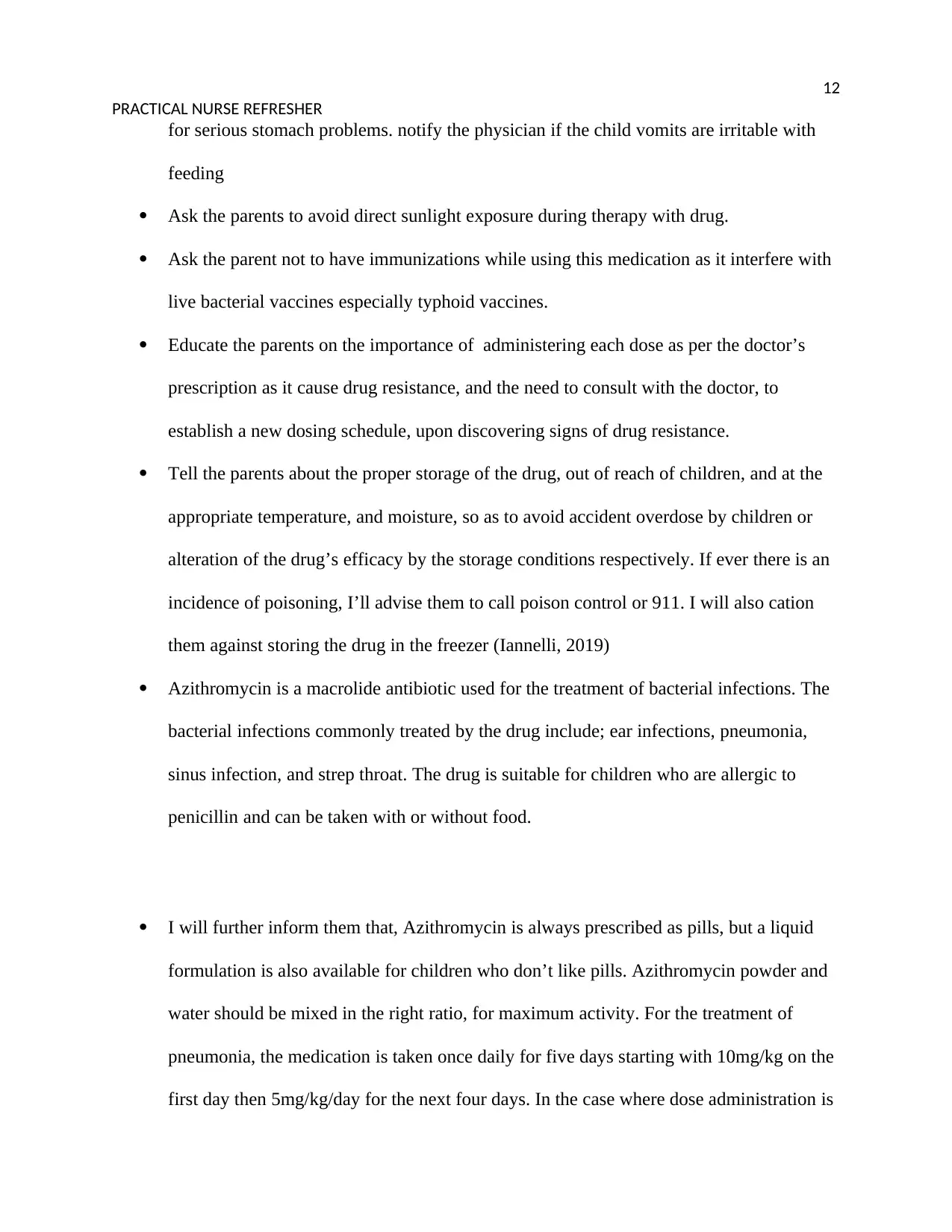
12
PRACTICAL NURSE REFRESHER
for serious stomach problems. notify the physician if the child vomits are irritable with
feeding
Ask the parents to avoid direct sunlight exposure during therapy with drug.
Ask the parent not to have immunizations while using this medication as it interfere with
live bacterial vaccines especially typhoid vaccines.
Educate the parents on the importance of administering each dose as per the doctor’s
prescription as it cause drug resistance, and the need to consult with the doctor, to
establish a new dosing schedule, upon discovering signs of drug resistance.
Tell the parents about the proper storage of the drug, out of reach of children, and at the
appropriate temperature, and moisture, so as to avoid accident overdose by children or
alteration of the drug’s efficacy by the storage conditions respectively. If ever there is an
incidence of poisoning, I’ll advise them to call poison control or 911. I will also cation
them against storing the drug in the freezer (Iannelli, 2019)
Azithromycin is a macrolide antibiotic used for the treatment of bacterial infections. The
bacterial infections commonly treated by the drug include; ear infections, pneumonia,
sinus infection, and strep throat. The drug is suitable for children who are allergic to
penicillin and can be taken with or without food.
I will further inform them that, Azithromycin is always prescribed as pills, but a liquid
formulation is also available for children who don’t like pills. Azithromycin powder and
water should be mixed in the right ratio, for maximum activity. For the treatment of
pneumonia, the medication is taken once daily for five days starting with 10mg/kg on the
first day then 5mg/kg/day for the next four days. In the case where dose administration is
PRACTICAL NURSE REFRESHER
for serious stomach problems. notify the physician if the child vomits are irritable with
feeding
Ask the parents to avoid direct sunlight exposure during therapy with drug.
Ask the parent not to have immunizations while using this medication as it interfere with
live bacterial vaccines especially typhoid vaccines.
Educate the parents on the importance of administering each dose as per the doctor’s
prescription as it cause drug resistance, and the need to consult with the doctor, to
establish a new dosing schedule, upon discovering signs of drug resistance.
Tell the parents about the proper storage of the drug, out of reach of children, and at the
appropriate temperature, and moisture, so as to avoid accident overdose by children or
alteration of the drug’s efficacy by the storage conditions respectively. If ever there is an
incidence of poisoning, I’ll advise them to call poison control or 911. I will also cation
them against storing the drug in the freezer (Iannelli, 2019)
Azithromycin is a macrolide antibiotic used for the treatment of bacterial infections. The
bacterial infections commonly treated by the drug include; ear infections, pneumonia,
sinus infection, and strep throat. The drug is suitable for children who are allergic to
penicillin and can be taken with or without food.
I will further inform them that, Azithromycin is always prescribed as pills, but a liquid
formulation is also available for children who don’t like pills. Azithromycin powder and
water should be mixed in the right ratio, for maximum activity. For the treatment of
pneumonia, the medication is taken once daily for five days starting with 10mg/kg on the
first day then 5mg/kg/day for the next four days. In the case where dose administration is
⊘ This is a preview!⊘
Do you want full access?
Subscribe today to unlock all pages.

Trusted by 1+ million students worldwide
1 out of 15
Your All-in-One AI-Powered Toolkit for Academic Success.
+13062052269
info@desklib.com
Available 24*7 on WhatsApp / Email
![[object Object]](/_next/static/media/star-bottom.7253800d.svg)
Unlock your academic potential
Copyright © 2020–2025 A2Z Services. All Rights Reserved. Developed and managed by ZUCOL.